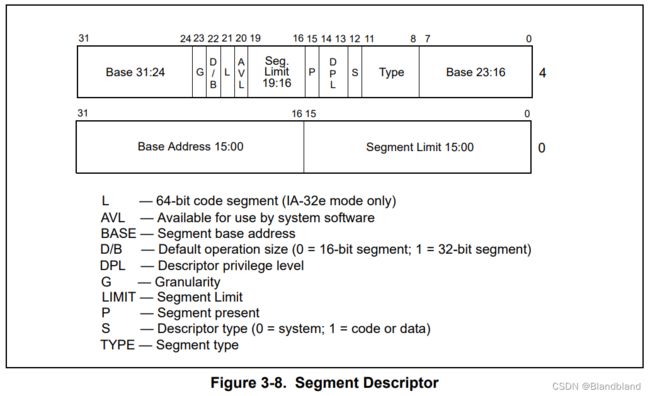【Linux0.11 源码历险记 2】《保护模式》
继续跟着stup.s 来看:
lidt idt_48 ; load idt with 0,0
lgdt gdt_48 ; load gdt with whatever appropriate
...
idt_48:
.word 0 ; idt limit=0
.word 0,0 ; idt base=0L
gdt_48:
.word 0x800 ; gdt limit=2048, 256 GDT entries
.word 512+gdt,0x9 ; gdt base = 0X9xxxx
在实模式下,ds 是段基址,但是在保护模式下,段基址是放在gdt里的,利用ds到gdt里取出每一段的段基址,同时还有一些其他的信息。下面就是一个段描述符的价绍,其实我在另一篇帖子也提到过(https://blog.csdn.net/lyk82698/article/details/127609577)

现在去找一个地址,就不再是简单的 ds + 偏移地址了。而是 ds 先去全局描述符表里找到对应的段描述符,然后根据段描述符里的内容作为段基址,结合偏移地址确定最终地址。而全局描述符表的位置,就放在寄存器 gdtr 里面。
| 47-16 | 15-0 |
|---|---|
| gdt起始地址 | gdt的长度限制 |
因此根据下面设置gdtr 表示gdt的限制和起始地址
gdt_48:
.word 0x800 ; gdt limit=2048, 256 GDT entries
.word 512+gdt,0x9 ; gdt base = 0X9xxxx
其中现在的 gdt 如图:
gdt:
.word 0,0,0,0 ; dummy
.word 0x07FF ; 8Mb - limit=2047 (2048*4096=8Mb)
.word 0x0000 ; base address=0
.word 0x9A00 ; code read/exec
.word 0x00C0 ; granularity=4096, 386
.word 0x07FF ; 8Mb - limit=2047 (2048*4096=8Mb)
.word 0x0000 ; base address=0
.word 0x9200 ; data read/write
.word 0x00C0 ; granularity=4096, 386
下面开A20 进入保护模式;
call empty_8042 ! 测试8042状态寄存器,等待输入缓冲器空,
mov al,#0xD1 ! command write 0xD1命令码表示写数据到8042的P2端口
out #0x64,al
call empty_8042 !等待输入缓冲器空,看命令是否被接受
mov al,#0xDF ! A20 on
out #0x60,al
call empty_8042 !若此时输入缓冲器为空,则表示A20线也选通
为了兼容。早期8086CPU 只有20根线,到32位后,需要向前兼容,一开始是限制地址只能20位的,这里就打开限制。
well, that went ok, I hope. Now we have to reprogram the interrupts :-(
; we put them right after the intel-reserved hardware interrupts, at
; int 0x20-0x2F. There they won't mess up anything. Sadly IBM really
; messed this up with the original PC, and they haven't been able to
; rectify it afterwards. Thus the bios puts interrupts at 0x08-0x0f,
; which is used for the internal hardware interrupts as well. We just
; have to reprogram the 8259's, and it isn't fun.
mov al,#0x11 ; initialization sequence
out #0x20,al ; send it to 8259A-1
.word 0x00eb,0x00eb ; jmp $+2, jmp $+2
out #0xA0,al ; and to 8259A-2
.word 0x00eb,0x00eb
mov al,#0x20 ; start of hardware int's (0x20)
out #0x21,al
.word 0x00eb,0x00eb
mov al,#0x28 ; start of hardware int's 2 (0x28)
out #0xA1,al
.word 0x00eb,0x00eb
mov al,#0x04 ; 8259-1 is master
out #0x21,al
.word 0x00eb,0x00eb
mov al,#0x02 ; 8259-2 is slave
out #0xA1,al
.word 0x00eb,0x00eb
mov al,#0x01 ; 8086 mode for both
out #0x21,al
.word 0x00eb,0x00eb
out #0xA1,al
.word 0x00eb,0x00eb
mov al,#0xFF ; mask off all interrupts for now
out #0x21,al
.word 0x00eb,0x00eb
out #0xA1,al
上面就是对8259进行编码。具体咱就不看了。
下面就正式进入保护模式:
mov ax,#0x0001 ; protected mode (PE) bit
lmsw ax ; This is it;
jmpi 0,8 ; jmp offset 0 of segment 8 (cs)
前两行,将 cr0 这个寄存器的位 0 置 1,模式就从实模式切换到保护模式了。进入保护模式,DS,CS等就变成了段选择子,他们相当于GDT的索引,进入GDT进行选择,同时还带着特权等级。
jmpi 0,8 ; jmp offset 0 of segment 8 (cs)
再往后,又是一个段间跳转指令 jmpi,后面的 8 表示 cs(代码段寄存器)的值,0 表示偏移地址。请注意,此时已经是保护模式了,之前也说过,保护模式下内存寻址方式变了,段寄存器里的值被当做段选择子。
8 用二进制表示就是
00000,0000,0000,1000
对照上面段选择子的结构,可以知道描述符索引值是 1,也就是要去全局描述符表(gdt)中找第一项段描述符。
所以,这里取的就是这个代码段描述符,段基址是 0,偏移也是 0,那加一块就还是 0 咯,所以最终这个跳转指令,就是跳转到内存地址的 0 地址处,开始执行。
下面就要进入 head.s 去执行了。